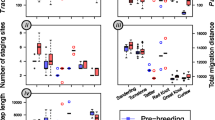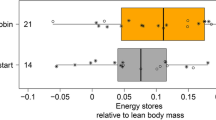Abstract
We investigated migration and wintering of adult northern gannets (Morus bassanus) breeding in east Scotland, North Sea, by deploying geolocation loggers over three winters. The wintering ranges of these birds varied from the North Sea to the Atlantic off West Africa. Flight time was taken as a proxy for migration and foraging effort. Gannets wintering off Africa had higher total flight times during migration than birds wintering further north. Total flight times in different wintering regions were generally low. Birds off West Africa consistently spent < 25 % of daylight hours in flight, but birds further north showed more variable values that may reflect more variable weather or food availability. Winter sea surface temperatures ranged from 9 °C (North Sea) to 16 °C (West Africa). Thermostatic costs in winter as estimated by measuring thermal conductance in carcasses in still air and water were 28 % higher in North Sea than off West Africa. This effect is aggravated by higher thermostatic costs caused by stronger wind chills in the North Sea compared to the conditions off West Africa. Birds wintering close to the UK arrived at the colony on average 12 days earlier than birds wintering off West Africa. We conclude that the net cost-benefit analysis may be similar for all wintering areas investigated.





Similar content being viewed by others
References
Atkinson PW, Baker AJ, Bennett KA, Clark NA, Clark JA, Cole KB, Dekinga A, Dey A, Gillings S, González PM, Kalasz K, Minton CDT, Newton J, Niles LJ, Piersma T, Robinson RA, Sitters HP (2007) Rates of mass gain and energy deposition in red knot on their final spring staging site is both time- and condition-dependent. J Appl Ecol 44:885–895
Bächler E, Hahn S, Schaub M, Arlettaz R, Jenni L, Fox JW, Afanasyev V, Liechti F (2010) Year-round tracking of small trans-Saharan migrants using light-level geolocators. PLoS ONE 5:e9566
Bairlein F (1991) Body mass of Garden Warblers (Sylvia borin) on migration: a review of field data. Vogelwarte 36:48–61
Bates D, Maechler M, Dai B (2008) Linear mixed-effects models using S4 classes. Version 0.999375-25, http://lme4.r-forge.r-project.org/
Berthold P (1996) Control of bird migration. Springer, Berlin
Berthold P, Schlenker R (1975) Das “Mettnau-Reit-Illmitz-Programm”—ein langfristiges Vogelfangprogramm der Vogelwarte Radolfzell mit vielfältiger Fragestellung. Vogelwarte 28:97–123
Birt-Friesen VL, Montevecchi WA, Cairns DK, Macko SA (1989) Activity-specific metabolic rates of free-living northern gannets and other seabirds. Ecology 70:357–367
Bruderer B (2003) The radar window to bird migration. In: Berthold P, Gwinner E, Sonnenschein E (eds) Avian migration. Springer, Heidelberg, pp 347–358
Bryant DM, Furness RW (1995) Basal metabolic rates of North Atlantic seabirds. Ibis 137:219–226
Calder WA, King JR (1974) Thermal and caloric relations of birds. In: Farner DS, King JR (eds) Avian Biology. Academic Press, New York, pp 259–413
Camphuysen CJ, van Dijk J (1983) Zee- en kustvogels langs de Nederlandse kust, 1974–79. Limosa 56:81–230
Cayan DR (1980) Large-scale relationships between sea surface temperature and surface air temperature. Monthly Weather Rev 108:1293–1301
Cunningham RO (1866) On the solan goose, or gannet (Sula bassana, Linn.). Ibis 8:1–23
Daunt F, Afanasyev V, Silk JRD, Wanless S (2006) Extrinsic and intrinsic determinants of winter foraging and breeding phenology in a temperate seabird. Behav Ecol Sociobiol 59:381–388
de Vries J, van Eerden MR (1995) Thermal conductance in aquatic birds in relation to the degree of water contact, body mass, and body fat: energetic implications of living in a strong cooling environment. Physiol Zool 68:1143–1163
Enstipp MR, Daunt F, Wanless S, Humphreys EM, Hamer KC, Benvenuti S, Grémillet D (2006) Foraging energetics of North Sea birds confronted with fluctuating prey availability. In: Boyd IL, Wanless S, Camphuysen CJ (eds) Top predators in marine ecosystems. Cambridge University Press, Cambridge, pp 191–210
Enstipp MR, Grémillet D, Jones DR (2008) Heat increment of feeding in double-crested cormorants (Phalacrocorax auritus) and its potential for thermal substitution. J Exp Biol 211:49–57
Faraway JJ (2006) Extending the linear model with R: generalized linear, mixed effects and nonparametric regression models. Chapman and Hall, London
Fifield D (2011) Winter areas and migratory tactics of northern gannets (Morus bassanus) breeding in North America. MSc thesis, Memorial University of Newfoundland, St. John’s
Fort J, Porter WP, Grémillet D (2009) Thermodynamic modelling predicts energetic bottleneck for seabirds wintering in the northwest Atlantic. J Exp Biol 212:2483–2490
Fort J, Pettex E, Tremblay Y, Lorentsen S-H, Garthe S, Votier S, Pons JB, Siorat F, Furness RW, Grecian WJ, Bearhop S, Montevecchi WA, Grémillet D (2012) Meta-population evidence of oriented chain migration in northern gannets (Morus bassanus). Frontiers Ecol Environ. doi:http://dx.doi.org/10.1890/110194
Garthe S, Grémillet D, Furness RW (1999) At-sea-activity and foraging efficiency in chick-rearing Northern Gannets (Sula bassana): a case study in Shetland. Mar Ecol Prog Ser 185:93–99
Garthe S, Benvenuti S, Montevecchi WA (2003) Temporal patterns of foraging activities of northern gannets Morus bassanus in the north-west Atlantic. Can J Zool 81:453–461
Gatter W (2000) Vogelzug und Vogelbestände in Mitteleuropa. 30 Jahre Beobachtung des Tagzugs am Randecker Maar. Aula Verlag, Wiebelsheim
Gauthreaux SA Jr, Belser CG (2003) Radar ornithology and biological conservation. Auk 120:266–277
Green M, Alerstam T, Clausen P, Drent R, Ebbinge BS (2002) Dark-bellied Brent Geese Branta bernicla bernicla, as recorded by satellite telemetry, do not minimize flight distance during spring migration. Ibis 144:106–121
Green JA, Boyd IL, Woakes AJ, Warren NL, Butler PJ (2005) Behavioural flexibility during year-round foraging in macaroni penguins. Mar Ecol Prog Ser 296:183–196
Griffiths R, Double MC, Orr K, Dawson RJG (1998) A DNA test to sex most birds. Mol Ecol 7:1071–1075
Griswold CK, Taylor CM, Norris DR (2010) The evolution of migration in a seasonal environment. Proc R Soc B 277:2711–2720
Hamer KC, Phillips RA, Wanless S, Harris MP, Wood AG (2000) Foraging ranges, diets and feeding locations of gannets Morus bassanus in the North Sea: evidence from satellite telemetry. Mar Ecol Prog Ser 200:257–264
Humphreys EM, Wanless S, Bryant DM (2007) Elevated metabolic costs while resting on water in a surface feeder: the Black-legged Kittiwake Rissa tridactyla. Ibis 149:106–111
Humphries MM, Careau V (2011) Heat for nothing or activity for free? Evidence and implications of activity-thermoregulatory heat substitution. Integr Comp Biol 51:419–431
Hüppop O, Hüppop K (2011) Bird migration on Helgoland: the yield from 100 years of research. J Ornithol 152(Suppl 1):S25–S40
Hüppop K, Dierschke J, Dierschke V, Hill R, Jachmann KF, Hüppop O (2010) Phänologie des, sichtbaren’’ Vogelzugs über der Deutschen Bucht. Vogelwarte 48:181–267
Kubetzki U, Garthe S, Fifield D, Mendel B, Furness RW (2009) Individual migratory schedules and wintering areas of northern gannets. Mar Ecol Prog Ser 391:257–265
Lack D, Varley GC (1945) Detection of birds by radar. Nature 156:446
Lewis S, Benvenuti S, Daunt F, Wanless S, Dall’Antonia L, Luschi P, Elston DA, Hamer KC, Sherratt TN (2004) Partitioning of diving effort in foraging trips of northern gannets. Can J Zool 82:1910–1916
LWVT/SOVON (Landelijke Werkgroep Vogeltrektellen/Samenwerkende Organisaties Vogelonderzoek Nederland) (2002) Vogeltrek over Nederland 1976–1993. Schuyt & Co., Haarlem
Meltofte H, Faldborg J (1987) Forekomsten af måger og terner på Blåvandshuk 1963–1977. Dansk Ornithol For Tidsskr 81:137–166
Morrison PR, Tietz WJ (1957) Cooling and thermal conductivity in three small Alaskan mammals. J Mammal 39:78–87
Nelson JB (2002) The Atlantic gannet. Fenix Books, Norfolk
Newton I (2008) The migration ecology of birds. Elsevier, Amsterdam
Pennycuick CJ, Bradbury TAM, Einarsson Ó, Owen M (1999) Response to weather and light conditions of migrating Whooper Swans Cygnus cygnus and flying height profiles, observed with the Argos satellite system. Ibis 141:434–443
R Development Core Team (2008) R: a language and environment for statistical computing. R Foundation for Statistical Computing, Vienna, Austria. ISBN 3-900051-07-0, http://www.R-project.org
Shaffer SA, Tremblay Y, Weimerskirch H, Scott D, Thompson DR, Sagar PM, Moller H, Tylor GA, Foley DG, Block BA, Costa DP (2006) Migratory shearwaters integrate oceanic resources across the Pacific Ocean in an endless summer. Proc Nat Acad Sci USA 103:12799–12802
Stutchbury BJM, Tarof SA, Done T, Gow E, Kramer PM, Tautin J, Fox JW, Afanasyev V (2009) Tracking long-distance songbird migration by using geolocators. Science 323:896
Ueta M, Sato F, Nakagawa H, Mita N (2000) Migration routes and differences of migration schedule between adult and young Steller’s Sea Eagles Haliaeetus pelagicus. Ibis 142:35–39
Walsberg GE (1988) Heat flow through avian plumages: the relative importance of conduction, convection, and radiation. J Therm Biol 13:89–92
Wernham CV, Toms M, Marchant J, Clark J, Siriwardena G, Baillie S (eds) (2002) The migration atlas: movements of the birds of Britain and Ireland. Poyser, London
Wilson RP, Ducamp JJ, Rees WG, Culik BM, Nickamp K (1992) Estimation of location: global coverage using light intensity. In: Priede IG, Swift SM (eds) Wildlife telemetry: remote monitoring and tracking of animals. Ellis Horwood, New York, pp 131–134
Wilson RP, Weimerskirch H, Lys P (1995) A device for measuring seabird activity at sea. J Avian Biol 26:172–175
Acknowledgments
This study was part of the EU-funded project ‘DISCBIRD’ (‘Effects of changes in fishery discarding rates on seabird communities’, contract Q5RS-2001-00839). The experiments comply with the current laws of the UK. J. Crane, O. Engelhard and S.C. Votier helped with field work. Molecular sexing was carried out by K. Griffiths. Sir Hew Hamilton-Dalrymple allowed us to work on the Bass Rock, and the Marr family provided safe transport to and from the island. S. Adler guided us on the use of GLMMs. G. Peters (earth & ocean technologies, Kiel, Germany) provided technical advice. M. Molis (Alfred Wegener Institute for Polar and Marine Research, Helgoland, Germany) kindly provided the data loggers for the thermal conductivity measurements.
Author information
Authors and Affiliations
Corresponding author
Additional information
Communicated by J. D. R. Houghton.
Rights and permissions
About this article
Cite this article
Garthe, S., Ludynia, K., Hüppop, O. et al. Energy budgets reveal equal benefits of varied migration strategies in northern gannets. Mar Biol 159, 1907–1915 (2012). https://doi.org/10.1007/s00227-012-1978-6
Received:
Accepted:
Published:
Issue Date:
DOI: https://doi.org/10.1007/s00227-012-1978-6




